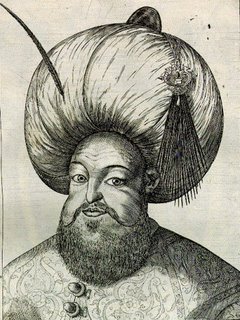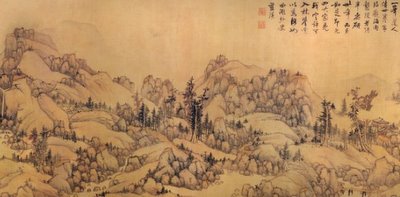



Arthur Rackham (1867-1939) was a prolific book illustrator and is best known for his fantasy art work for fairy tales and the classic childrens' books. He maintains a sense of reality by giving his creations human foibles and there is often an edge to his work. He was successful at a time when luxuriously printed gift books were widely popular. He did do some adult book illustrations and his artwork was of sufficient calibre that a painting of his was hung in Le Louvre.
Saturday, November 05, 2005
Arthur Rackham
Hatwear of the Eurostocracy
These portraits come from Atrium Heroicum Caesarum c. 1600 by Dominicus Custos. The 100-odd copper engravings of royalty, nobility and elite troops from all over Europe were made from paintings. The subjects lived in the 15th and 16th centuries.
With respect to the names above that were crunched by translation and are probably a little wrong ... as the website says..
"We ask the bent reader for indulgence and if necessary for friendly report!"
Atrium Heroicum Caesarum is hosted by the University of Mannheim. (translation)
The Red-Haired Barbarians
For more than 200 years the only direct contact Japan had with the west was via the trading station set up on a tiny man-made island, Dejima (map) in Nagasaki. Originally Portuguese traders were allowed in but after a Japanese christian uprising in 1637 which was overcome with the help of Holland, Dutch merchants were the sole westerners with trading rights until 1853.
 Dutch King William III - Text: "Even the people
Dutch King William III - Text: "Even the peoplewho write with crabbed hand are craving for
the Elevated Way of our Country"
The International Institute for Social History in Holland have a modest exhibit, The Red-Haired Barbarians, in english, of woodblock prints that were made from word of mouth descriptions or brief glimpses caught of the strange foreigners in their midst during the sakoku of the Edo period. The prints were published and sold to tourists visiting Nagasaki. It was mildly amusing reading the attitude in some of the text in the exhibit.
Friday, November 04, 2005
Chinese Scroll Paintings
"The artist Lan Ying was one of the most skillful and accomplished artists of the late Ming dynasty, active in Hangzhou, Zhejiang in the first half of the seventeenth century. He was a professional artist who was able to paint in the styles of many great artists of the past. For this reason he won the admiration of contemporary scholars, connoisseurs, and collectors of art. This large handscroll is a mountainous landscape on silk painted with brushes in ink and water-based pigments."

The Center for the Art of East Asia at the University of Chicago have this year established a website in which a unique flash interface allows visitors to scroll through old manuscripts in the manner that was intended.
There are only three works available at present. The above Landscape after Huang Gongwang ink on silk was painted in c.1637. The image below comes from the wonderful ink rubbing c. 25 feet long Wangchuantu that was completed early in the 19th century but derives from an 8th century scroll. Originally there were 20 poems on a temple wall that accompanied 20 painted scenic locations from the rural property of fabled writer Wang Wei. Time and multiple reproductions have conferred some alterations onto the extant copy.
They're not as visually spectacular as some illustrations perhaps but it's good to have internet access to these works whose fragility means they can't even be put on physical display. It's a kind of a slight privilege to be able to see them like this actually. The image below doesn't really capture the detail and quality that the zippy zooming at the site demonstrates.

Pochoir



"Pochoir is a refined stencil-based technique employed to create prints or to add color to pre-existing prints. It was most popular from the late 19th century through the 1930's with its center of activity in Paris. Pochoir was primarily used to create prints devoted to fashion, patterns, and architectural design and is most often associated with Art Nouveau and Art Deco." -- "The pochoir process is the hand-coloring of an individual black outline prints. The was done with the help of a thin zinc or copper cut-out stencil guide. Each color is applied separately brushed by hand on each print, one stencil for each color."Vibrant Visions: Pochoir Prints in the Cooper-Hewitt, National Design Museum Library - at the Smithsonian Institute.
Also: George Barbier at artophile and Pochoir artists at Art Deco Prints & Posters. [and previously]
Birds Eye Viewing




Tom Patterson is a cartographer from the US National Parks Service and in his shadedrelief.com cartography website, there is a gallery of birds-eye view illustrations from a number of illustrators (and more). He has a very interesting website for the cartographically inclined.
- Random bonus: Unrealized Moscow - for those who haven't seen these wonderful architectural drawings of soviet structures from 1930s to 1950s that were never built.
- Random note: GooglePrint beta has gone live - search inside books with small batch jpeg pages resulting. It's both a great and thought provoking service at the same time. Do some random searching to get a feel for the scope of the database. 'Illustration' returns 640,000 pages.
Thursday, November 03, 2005
Dentata



The top illustration is from Canis carchariæ by Niels Stensen or Nicolaus Steno in 1667 from the Danish National Library.
The other two images were not sourced.
Alonso de Ovalle's Chile



Alonso de Ovalle (1603-1651) from Chile joined the Jesuit order of priests as a young man and studied theology and philosophy and did missionary work among the native indians. He was sent to Europe to obtain resources and monks to continue the missionary work. When he got there he was astonished to find that most people in Europe had not heard of his beloved Chile.



So de Ovalle wrote an historical 'encyclopedic' book about his country. Histórica Relación del Reyno de Chile was first published in latin in 1646 and translated into Italian the following year. Although he consulted widely for factual material, the majority of the work consists of his describing all that he knew in relation to the geography and minerals and natives and customs and flora/fauna and the colonial military powers of Chile. I didn't note any information about the illustrations. I'm not even sure if they were issued when the book was first published. The imagery is striking (when it's not obviously filched from traditional renaissance sources) and not overly positive in its representation of the indians. The Christ on a tree motif is surreal and I wonder if it's an original for this work, if anyone knows? [The titles of each illustration are in the image URLs]
I didn't note any information about the illustrations. I'm not even sure if they were issued when the book was first published. The imagery is striking (when it's not obviously filched from traditional renaissance sources) and not overly positive in its representation of the indians. The Christ on a tree motif is surreal and I wonder if it's an original for this work, if anyone knows? [The titles of each illustration are in the image URLs]
- Histórica Relación del Reyno de Chile is presented online by Memoria Chilena - the first 2 links in the final paragraph on this page contain the major illustrations (translation). The site itself is quite worthy of a wander; they have a modest collection of books and images posted, and I will surely return there to check it out further.
- A short review from the José Durand library at Notre Dame University.
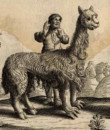
Wednesday, November 02, 2005
Sketch Coping

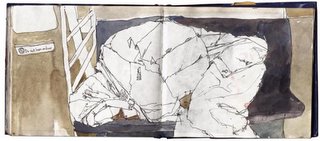

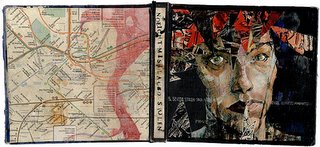
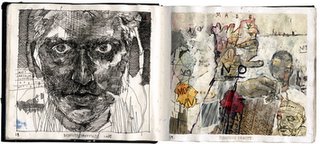
Looks like it's sketchbook day here. I wasn't looking for it but it did come up on the radar and I don't think it has been posted around at all or much. There are about 15 journals with no more than 10 pages in each. It is an ajaxy interface that works pretty well. He also has art. Edgy eclectic and unsual. It made me pause. So it has been successful for this perusing visual commuter.
© John Copeland - you'll find the sketchbooks under 'journals' so perhaps they're journals and not sketchbooks. But a journal is a book right? So it's within the purview of BibliOdyssey.
"I keep small visual journals, which serve as a place to document my surroundings and work out pictures on a small scale. I take depictions of scenes, objects, and people around me, and recast them as visual metaphors, within larger works that talk about psychology, communication, struggle, and isolation. Text is often built up as texture and as a subtext to the imagery. Figures in urban settings, still lives of discarded objects, advertising, windows and trees are common subjects."
Dans le Jardin

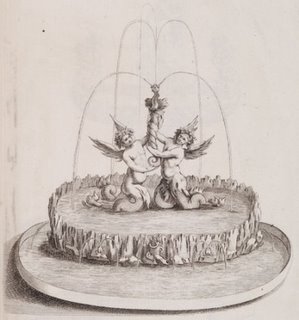
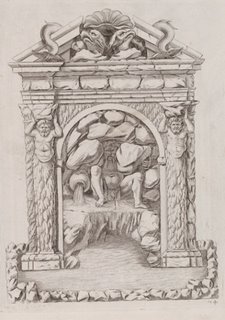
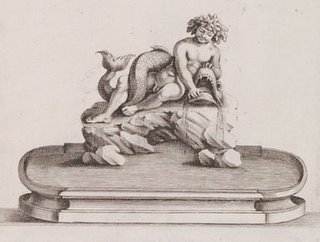

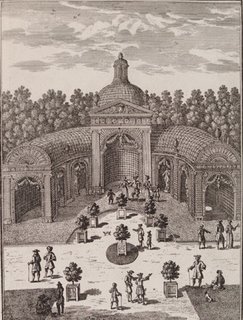
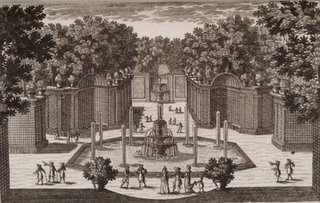
After completion in 1668, the gardens at the Palace of Versailles (by André Le Nôtre) became renowned throughout Europe. Models of the gardens together with french gardeners and french landscape architects became popular with the elite across the continent. It was into this atmosphere that famous landscape designer/gardeners Michel Le Bouteux and André Le Nôtre released their Plans et Dessins Nouveaux de Jardinage in c. 1680-1690.
The short volume with 109 pages of copper plate engravings (quite a few are double pages) provided garden plans, example fountains and structural elements over which the francophilic gardening set could drool. Many, if not all of the fountain illustrations were copied from Italian Agostino Ramelli's 16th century automata / water-engineering book.
Missouri Botanical Gardens' Rare Books Department have Plans et Dessins Nouveaux de Jardinage available in a fast, smart interface. Another first class website.
Les Carnets de Benjamin Lemoine



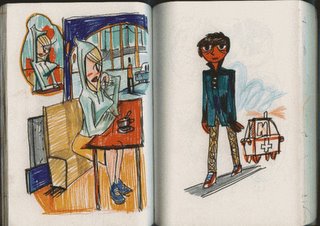
I'm not usually much of an aficionado of the comicbook-type genre. Perhaps it was the voyeurism of being able to thumb through four years of someone's random doodles or perhaps the stars were in alignment today.
Benjamin Lemoine has posted his seasonal sketchbooks since 2001 online. The interface is fine, it's easy just to flick through. I do like his eye, although there is a fair bit of dross between the islands of delight (for me...today, anyway).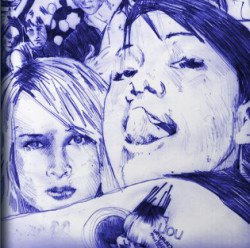
It reminds me to an extent of the recent and wonderful DQ3, which I haven't bothered to post because I thought most people coming here will have seen it - it's been out a few months and was posted all around the traps. DQ3 is a turn-the-pages sketchbook flash site and is superb.






